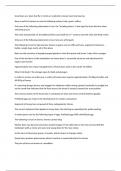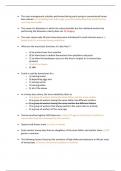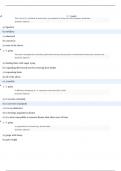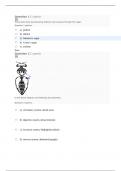University of Guelph (U OF G ) • ENVS 2210 Introductory Apiculture
Latest uploads for ENVS 2210 Introductory Apiculture at University of Guelph (U OF G ). Looking for ENVS 2210 Introductory Apiculture notes at University of Guelph (U OF G )? We have lots of notes, study guides and study notes available for ENVS 2210 Introductory Apiculture at University of Guelph (U OF G ).
-
5
- 0
- 0
Courses ENVS 2210 Introductory Apiculture at University of Guelph (U OF G )
Notes available for the following courses of ENVS 2210 Introductory Apiculture at University of Guelph (U OF G )
-
ENVS 2210 4
-
ENVS 2210 Introductory Apiculture 1
Latest notes & summaries University of Guelph (U OF G ) • ENVS 2210 Introductory Apiculture

Scout bees are: bees that fly in circles or randomly to locate new food sources Bees as well as humans can see the following colours: blue, green, yellow Only one of the following statements is true: the “breaking dance” is the signal to leave the hive when swarming occurs The main characteristic of all traditional hives used until the 17th century was that: they had fixed combs Only one of the following statements is true: bees are arthropods The following is true for Apis dorsata: kn...
- Exam (elaborations)
- • 40 pages's •
-
University of Guelph•ENVS 2210
Preview 4 out of 40 pages
Scout bees are: bees that fly in circles or randomly to locate new food sources Bees as well as humans can see the following colours: blue, green, yellow Only one of the following statements is true: the “breaking dance” is the signal to leave the hive when swarming occurs The main characteristic of all traditional hives used until the 17th century was that: they had fixed combs Only one of the following statements is true: bees are arthropods The following is true for Apis dorsata: kn...

• The main management activities performed during early spring in overwintered honey bee colonies are a) feeding them with sugar syrup & b) expanding their brood nest by reversing hive bodies • The name of a behaviour in which the colony benefits but the individual worker bee performing the behaviour clearly does not. B) stinging • The main reason why African honey bees were introduced to south America was a) to breed them for increased honey production • What are the most basic f...
- Exam (elaborations)
- • 12 pages's •
-
University of Guelph•ENVS 2210
Preview 2 out of 12 pages
• The main management activities performed during early spring in overwintered honey bee colonies are a) feeding them with sugar syrup & b) expanding their brood nest by reversing hive bodies • The name of a behaviour in which the colony benefits but the individual worker bee performing the behaviour clearly does not. B) stinging • The main reason why African honey bees were introduced to south America was a) to breed them for increased honey production • What are the most basic f...

1 / 1 point This race of A. mellifera is particularly susceptible to American and European foulbrood Question options: a) ligustica b) mellifera c) adansonii d) caucasica e) none of the above n 1 / 1 point The main management activities performed during early spring in overwintered honey bee colonies are Question options: a) feeding them with sugar syrup b) expanding their brood nest by reversing hive bodies c) requeening them d) all of the above e) a) and b) n 1 / 1 point A d...
- Exam (elaborations)
- • 16 pages's •
-
University of Guelph•ENVS 2210
Preview 3 out of 16 pages
1 / 1 point This race of A. mellifera is particularly susceptible to American and European foulbrood Question options: a) ligustica b) mellifera c) adansonii d) caucasica e) none of the above n 1 / 1 point The main management activities performed during early spring in overwintered honey bee colonies are Question options: a) feeding them with sugar syrup b) expanding their brood nest by reversing hive bodies c) requeening them d) all of the above e) a) and b) n 1 / 1 point A d...

Question 1 (1 point) Honey bees hear by perceiving airborne sound waves through this organ Question 1 options: a) pedicel b) labrum c) Johnston’s organ d) Caron’s organ e) arolium Save Question 2 (1 point) In the above diagram, the following are presented Question 2 options: a) circulatory system, dorsal aorta b) digestive system, dorsal intestine c) excretory system, Malpighian tubules d) nervous system, abdominal ganglia e) respiratory system, air sacs and position of spira...
- Exam (elaborations)
- • 17 pages's •
-
University of Guelph•ENVS 2210 Introductory Apiculture
Preview 2 out of 17 pages
Question 1 (1 point) Honey bees hear by perceiving airborne sound waves through this organ Question 1 options: a) pedicel b) labrum c) Johnston’s organ d) Caron’s organ e) arolium Save Question 2 (1 point) In the above diagram, the following are presented Question 2 options: a) circulatory system, dorsal aorta b) digestive system, dorsal intestine c) excretory system, Malpighian tubules d) nervous system, abdominal ganglia e) respiratory system, air sacs and position of spira...

Research Journal Article Paper Honey bee waggle dance communication: signal meaning and signal noise affect dance follower behaviour ENVS 2210
- Exam (elaborations)
- • 6 pages's •
-
University of Guelph•ENVS 2210
Preview 2 out of 6 pages
Research Journal Article Paper Honey bee waggle dance communication: signal meaning and signal noise affect dance follower behaviour ENVS 2210
